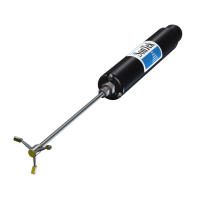SonTek/YSI
82
ADVField Operation Manual (September 1, 2001)
5.1.2. 5-MHz ADVOcean Probe
When collecting data in beam or XYZ coordinates, the positive Z-axis of the ADVOcean probe
is defined along the axis of the acoustic transmitter from the sampling volume towards the acous-
tic sensor. The positive X-axis is defined from the acoustic transmitter to receiver #1 (marked by
a machined dimple on the sensor head). The positive Y-axis is defined to give a right-hand coor-
dinate system.
5.2. Serial Communication Protocol
The ADVField processing module supports RS232, RS422, and RS485 serial communication
protocols. Switching between RS232 and RS422 changes only the electrical interface and has no
effect on the command interface. RS485 communication uses a modified command interface and
modified data acquisition software. See §4.2 for information about the hardware switches and
jumpers used to change the serial communication protocol.
RS232
is the default protocol setting. This is the same protocol used by standard serial ports on
PC-compatible computers, and is considered reliable for cable lengths to about 100 m.
RS422
communication uses differential voltage signals to increase immunity to external noise.
This allows operation over longer cables; RS422 is considered reliable for cable lengths to about
1500 m (when using twisted, shielded wires). RS422 communication affects only the electrical
signals used for communication and has no effect on the command interface or data acquisition
software. RS232-to-RS422 converters are available commercially and allow an ADV using
RS422 communication to be connected to the RS232 serial port of a PC-compatible computer.
One supplier for this type of converter is:
B&B Electronics Phone: (815) 434-0846 Part numbers:
707 Payton Rd Fax: (815) 434-7094 Converter – 422COR
Ottawa, IL 61350 USA www.bb-elec.com Power supply – 422PS2
RS485
communication uses the same electrical protocol as RS422, but adds an address message
to each transmission to allow multiple instruments to be controlled with one communication line.
This requires a modified command interface and modified data acquisition software that is not
presented in this manual. See §5.3 for a general description of the RS485 interface.
5.3. Multiple System Operation Using RS485
The ADVField processing module supports three serial communication protocols: RS232,
RS422, and RS485. The standard protocol used by PC-compatible computers is RS232, and is re-
liable over cable lengths to about 100 m (using high-quality, twisted, shielded cable similar to the
cable provided by SonTek). RS422 uses differential voltage signals to increase resistance to ex-
ternal interference and is reliable with cable lengths to about 1500 m. RS485 uses the same elec-
trical interface as RS422 and can also be used with long cables, but has the added feature of mes-
sage addressing that allows several instruments (each with a unique address) to be controlled
from one serial communication line.
In the ADVField, RS485 allows synchronized data collection from several ADV systems using
one computer. Cable length and sampling rate determine the maximum number of ADVs that can
be connected to a single port.
Configuring multiple ADVs for data collection using RS485 requires special cabling and soft-
ware (see Appendix 3).

